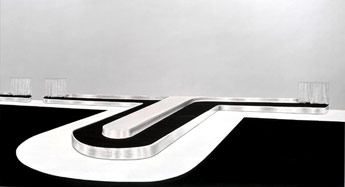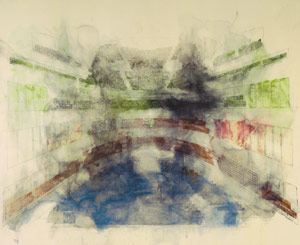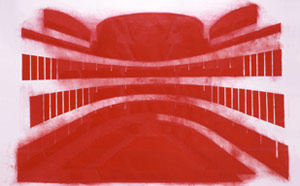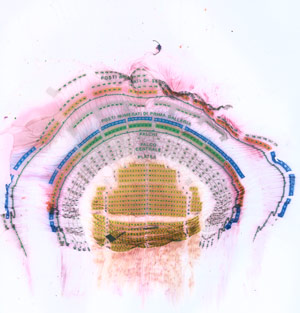A MAM Premiere
Guillermo Kuitca: Everything, Paintings and Works on Paper, 1980-2008


Miami Art Museum premiered the most comprehensive survey of the work of Argentine artist Guillermo Kuitca ever presented in North America. On view at MAM through January 17, 2010, Guillermo Kuitca: Everything, Paintings and Works on Paper, 1980-2008 traces the evolution of Kuitca’s work through more than 50 canvases and 25 works on paper, spanning 28 years of the artist’s career.
Guillermo Kuitca explores themes of dislocation and the intersection of public and private spaces through works ranging from early paintings of theatrical scenes, to complex abstractions which reference maps and architectural plans. Kuitca was the chosen representative of Argentina at the Venice Biennale in 2007, where he was one of only three artists with work on view in both a national pavilion and in the central international Biennale exhibition. The artist’s work was previously exhibited at the Center for Fine Arts, which later became the Miami Art Museum, in the 1995 exhibition Burning Beds Guillermo Kuitca: A Survey 1982-1994.

In addition to the artworks within Miami Art Museum’s on-site gallery space, the Museum will also host Guillermo Kuitca: Everything (else), at Miami’s Freedom Tower from October 27, 2009 through January 17, 2010. MAM is working with the Art Gallery System of Miami Dade College, which owns and operates this nationally designated landmark historic building, to install 32 Seating Plans, 2007 a piece comprised of 32 drawings and two large-scale paintings, Everything, 2004 and The Ring, 2002, each over 20 feet wide. Also on view for the first time will be “Der Fliegende Holländer” (Scrim Suite), 2009. Tracing its origins to the stage designs conceived by Kuitca for a 2003 production of Wagner’s The Flying Dutchman at the Teatro Colón in Buenos Aires, this installation explores the experience and perception of light, space and image through the medium of three silk scrims.

“Drawing inspiration from charts, maps and theater seating plans, Kuitca’s work challenges boundaries both literally and figuratively,” said Terence Riley, MAM Director. “MAM is a hemispheric hub for art across the Americas, and this exhibition is particularly relevant to MAM and the Miami community. We are pleased to present our second exhibition of Kuitca’s work, and look forward to presenting many more exhibitions of this scale and importance once MAM moves to its new, expanded facility at Museum Park.”
Dating to the early and mid-1980s, the earliest works in the exhibition reflect Kuitca’s experiences as a theatrical stage director in Argentina, with titles often drawn from plays, literature, and popular music. Works such as El Mar Dulce and Siete Ultima Canciones, both completed in 1986, are reminiscent of stage sets viewed from a distance, with tiny figures acting out mysterious and disturbing dramas. Themes of absence and loss emerged in subsequent works of this period, which depict overturned chairs, sullied beds that appear to be on fire and a microphone on an empty stage.

Kuitca’s works of the late 1980s and early 1990s explore architecture and topography, as well as domestic and communal spaces. The floor plans of public institutions (the “Tablada Suite”), geographical maps (the artist’s “map” paintings on canvases and mattresses), and genealogical charts (the “People on Fire” series) begin to serve as important references during this period. Though these works imply social interaction and public spaces, the human figure remains notably absent.
Kuitca further explored organizational systems throughout the 1990s and early 2000s. In Neufert Suite, 1998, a series of paintings, and L’Encyclopédie, 2002, a series of works on paper, he references an architect’s handbook and the work of French philosopher Denis Diderot, who attempted to condense the whole of human knowledge into an encyclopedia. In his series of drawings titled Global Order, 2002, Kuitca fuses a map of the world with building plans for domestic spaces, identifying borders and notions of “place” as the changing products of human invention.

Since the late 1990s, Kuitca has created both large and small-scale works on paper that explore and deconstruct his painted works. Continuing his investigation of mapping, Kuitca based a 2007 series on seating charts from renowned performance spaces such as the Metropolitan Opera House in New York. Kuitca selectively edits information from these charts in an electronic format before printing them. He then further alters their appearance and meaning by subjecting them to different water treatments which alter the printed image. The resulting works are surreal abstractions, whose pictorial elements have migrated across paper. Guillermo Kuitca: Everything, Paintings and Works on Paper, 1980-2008 explores the relationship between these recent works, which court accident through the use of procedures with random results.
Guillermo Kuitca: Everything, Paintings and Works on Paper, 1980-2008 includes Kuitca’s canvas Mozart-Da Ponte VI, 1996, from Miami Art Museum’s permanent collection, as well as two works included in the 2007 Venice Biennale, Desenlace I, 2006, and Desenlace IV, 2007. The exhibition also features Untitled, 1992, a piece comprised of 20 painted mattresses from the collection of Tate Modern.
The exhibition was co-organized by Albright-Knox Art Gallery, Buffalo, New York; the Hirshhorn Museum and Sculpture Garden, Smithsonian Institution, Washington, D.C.; and Miami Art Museum.


